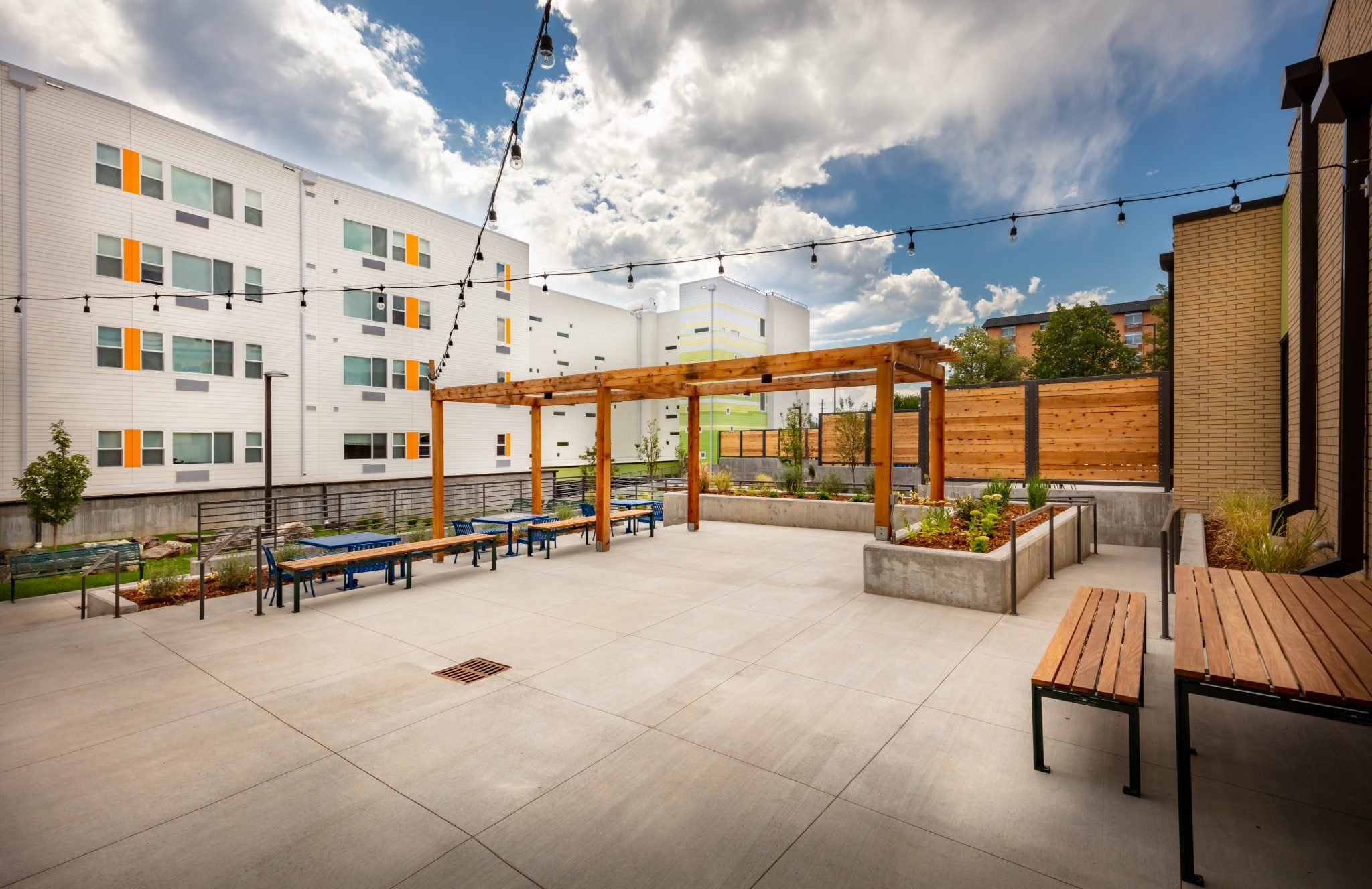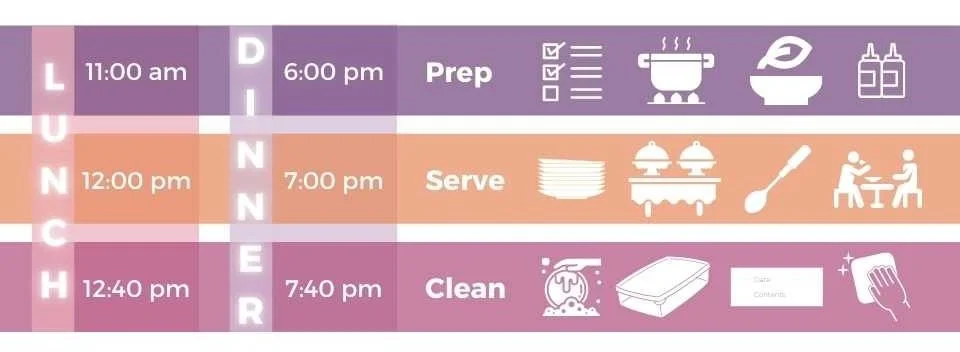
Meal Program Information
Weekly Meal Plans
Please remember to email your menu so we can include it on the Weekly Meal Plan, which is posted in the dining room for shelter guests.
Provide a Meal
Please provide 50 servings.
Current dietary restrictions:
one guest who is lactose intolerant
one guest allergic to gluten
one guest allergic to shellfish
one guest not able to eat tomato sauces/pastes, same guest not able to eat spicy (including pepper)
Do your best to accommodate dietary restrictions. You do not have to provide separate food items for each dietary restriction, but make sure to label any food items containing sensitive ingredients so we can inform guests appropriately.
Help nourish our guests by donating a healthy, balanced meal. This opportunity is open to individuals or small groups. Families are welcome. If you plan to volunteer on-site at the shelter, please limit your group to 6 volunteers due to the size of our kitchen.
You are welcome to cook a meal in our commercial kitchen at the shelter, cook a meal in your home, or order a meal from a restaurant to be delivered to the shelter. If you are dropping off a meal, we are happy to finish the meal on site.
Plan a complete menu with a main dish, side dish(es), salad(s), accompanying condiment(s) (no mustard, please!), beverages, and dessert as your budget allows. A unified meal rather than small amounts of many things expedites the meal service.
Purchase all ingredients and prepare the meal. Volunteers spend an average of $250 (and between $150-400 depending on menu and shopping location) on planned meals.
Dietary Restrictions
Dropping off a meal
Deliver the meal components no later than 11:00 am for lunch or 6:00 pm for dinner on the date you are scheduled.
Use large disposable rectangle aluminum pans.
Write the following on the outside of the meal containers:
Scheduled date for your meal
Lunch or Dinner
Name of the food item
Directions for reheating, cooking, or serving (tip: print the recipe you use, and tape it to the top of the container)
Any ingredient(s) from the dietary restrictions list that you included in the food item
Schedule alternative meal drop off time
Popular menu requests include:
World Cuisines -
Indian
Chinese
Thai
Middle Eastern
Hearty Salads
Hearty Soup
Pot Pie or Shepherd's Pie
Rice & Veggie Bowls
Fried Chicken or Fish with Roasted Fresh Veggies
Grilled or Baked Fish with Fries/Tots
Breakfast for Dinner
Check our Pinterest boards for other ideas
Cooking for a crowd
Shelter Meal Schedule
Serve a Meal
Serving a meal and joining our guests to eat is where many volunteers get their start and requires no financial contribution. We are looking for friendly, caring volunteers to assist with meal service at The Delores Project. As a meal server, you play a key role in raising the level of hospitality that we provide our guests each day. We ask meal servers to:
Prepare the planned meal or finish preparing the donated meal.
Clean and set-up the dining room for meal service.
Serve the meal to guests.
Put away leftovers and clean up following meal service.
Follow the guidelines, policies, and procedures for volunteering at The Delores Project, including provided food safety rules and guidelines.
The meal server checklist is detailed below:
Food Safety
Please follow all food safety guidelines mandated by the Department of Public Health & Environment as you prepare and serve food to prevent food-borne illnesses within our community.
Practice Good Hygiene Avoid Cross Contamination Maintain Appropriate Temperatures Practice Good Hygiene
Wash hands regularly, including:
before, during, and after preparing food;
after using the restroom;
after touching bare skin, trash, dirty dishes, uncooked eggs, raw meat, poultry, seafood, or their juices;
and after blowing your nose, coughing, sneezing, using tobacco, or eating.
Wear gloves when handling, preparing, and serving food. Keep in mind that your gloves become your second skin so keep them clean. Change gloves that rip or might be contaminated. Change gloves between working with raw and ready-to-eat foods. Throw gloves away after use. Never wash or re-use gloves.
Never touch ready-to-eat food with bare hands. Handle all food items with a utensil (spoon, tongs, etc) instead.
Avoid Cross Contamination
Clean and sanitize all food preparation surfaces before, during, and after food preparation.
Avoid cross contamination by using separate cutting boards, dishes, and utensils for produce, meat, poultry, seafood, and eggs.
Keep raw meat away from other food to prevent cross contamination.
Wash and sanitize surfaces that come in contact with raw meat.
Wash hands after handling raw meat.
Maintain Appropriate Temperatures
Bacteria multiply rapidly between 40 ° F and 140 ° F. To keep food out of this "Danger Zone," keep cold food cold and hot food hot. These foods include:
Animal products (includes eggs, dairy products)
Cooked starches (rice, beans, pasta, or potatoes)
Fruits and vegetables as follows: cooked vegetables, tofu, sprouts such as alfalfa or bean sprouts, or cut melons
Cold foods should be held at 40 ° F or colder. Keep items in a fridge or freezer or place food in containers on ice.
Hot foods should be held at 140 ° F or warmer. Keep hot food in an oven or use the Hotwell drop-ins when in the shelter kitchen.
Cook food to recommended temperatures. Use a food thermometer to check the internal temperature of food. Check in several places to be sure food is cooked to a safe temperature. Recommended temperatures include:
165 ° F for poultry, stuffed meat or fish, pasta, soups, stews, casseroles, and reheated foods
160 ° F for ground meats and eggs that are cooked and held for service, such as scrambled
145 ° F for whole beef, lamb, pork, fish, shellfish, and eggs that are broken, cooked, and served immediately
Potentially hazardous food can be at room temperature for up to two hours while you are preparing or transporting it. It must be thrown away if it is left out for more than 2 hours at room temperature.
Ready-to-eat food must be served within three days. Food must be labeled with the date prepared and the item name.
Kitchen Tour
The shelter's commercial kitchen is outfitted to meet all your needs for preparing and serving meals. A staff member can help you operate any equipment or find any items in the kitchen.
Equipment List
2 reach-in fridges
2 reach-in freezers
2 convection ovens (capacity of up to 10 full size (18"x26") baking sheets)
6-burner range with gas oven
Flat top grill with gas oven
2 Hotwell drop-in food wells
22-quart roaster oven
Outdoor propane flat-top grill
Item Inventory
Reusable plates, bowls, silverware, cups, and mugs for serving
Plastic drink pitchers
16-liter & 6-liter plastic Cambro containers + lids
Plastic food storage containers
Knife set, scissors, and pizza cutters (all stored in the pantry)
Plastic cutting boards
Small salad/herb spinner
Large and small metal and plastic mixing bowls (6-13 quart size)
Home-size plastic colander & commercial-size metal colander
Saute pans, frying pans, and woks
10-quart sauce pan
24-quart and 40- quart stock pots with lids
6 full sheet trays (18"x26") and 3 half-sheet/cookie trays
Assortment of disposable rectangle aluminum pans
Instant read thermometers
Box grater
Liquid & dry measuring cups & spoons
Can & bottle openers
Vegetable peelers
Potato masher
Rubber/silicone, wood, plastic, and metal spatulas
Metal and plastic serving spoons, forks, tongs, and ladles
Wire whisk & pastry scraper
Cake server
Ice cream scoop
Grill spatula and tongs
Aprons
Oven mitts
Kitchen towels



